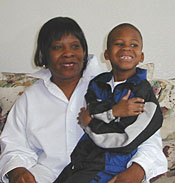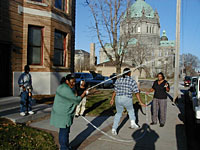
The Gap
by Carl Goldstein
April 2000
We're into the tenth year of the nation's longest economic expansion with no
end in sight. Minnesota is experiencing the lowest unemployment in a generation
and at least its share of stock market driven wealth. Many people are enjoying
the best times of their lives. But many others remain mired in poverty.
 |
 |

|
"Ultimately, I do want a part of the American dream," says Bea Molin-Walker (with John, age 6). "If I could own my home, that would be it, that would be a dream come true for me."
She just doesn't see it happening any time soon.
Photo: Carl Goldstein
|
|
 |
| |
WITH THE MEDIA AWASH
in stock market hype and reports of dotcom gazillionaires,
it's easy to forget all the people who feel they are on the outside looking in.
People like Bea Molin-Walker. "I know we're in a good economic state, this is what I hear, this is what I read, but I haven't seen a whole lot of it," says the 46-year-old single mom who lives in St. Paul.
She works as a receptionist at Conseco Finance in
Eagan. The job pays pretty well; she gets $10.75 an hour. But as a diabetic,
she's only able to put in 20 to 30 hours a week, and working less than
full-time means no health benefits.
What with the cost of MinnesotaCare health premiums, food and clothing for two
children, Molin-Walker says her $950 monthly pay is barely enough. The
fact she's able to get by at all is due to subsidized rent, which is set at $200
a month.
"I've done some research, what would happen if I was to move out
and lose my subsidy, would I be able to afford rent, if I was to move out of
here, I just wouldn't be able to do it."
Her shaky financial condition illustrates a key fact of life in the economic
boom. The U.S. economy has been an incredible job-creating machine. But a high
proportion of those positions are in low-end services rather than
manufacturing, and that means low pay.
"Wages tend to be tied to the growth in productivity, and
productivity in services is much lower than productivity growth in
manufacturing," says Louis Johnston, is an assistant professor of economics at the college of St. Benedict and St John's University.
This downward pressure on wages explains why 40 percent of all workers in Minnesota
earn less than $10 an hour. The simple fact so many workers are earning
so little means they can't afford boom-inflated housing costs.
Caty Royce, director of the Community Stabilization Project in St. Paul, a
housing advocacy group, blames the strong economy for the dire shortage of
affordable housing. "We have two factors combined giving us the worst housing crisis ever, a booming economy a highly inflated real estate market, and a very low vacancy rate," she says.
That vacancy rate keeps shelters in the Twin Cities full. They serve
many people who have jobs, but can't find an affordable place to live. Bea
Molin-Walker says she was one step from the shelters three years ago when her
old apartment was condemned. But at the last moment she found space in a
dilapidated apartment complex on St. Paul's Selby Avenue, right next to the St.
Paul Cathedral.
"When I moved in here the apartments were in bad need of repairs,
there were drug dealers, drug users, the whole bit right outside, had to
actually park my way through to get past them, they literally living and
sleeping in the halls of these apartments."
 |
 |

|
Even a success story like the Cathedral Hill Homes doesn't obscure what many
observers say is a broad failure by the state's political leadership to deal
with issues affecting people with low and moderate incomes.
Photo: Carl Goldstein
|
|
 |
| |
The place is different now - fresh masonry, spotless common hallways, cozy two
and three bedroom apartments. Residents and affordable housing activists
pressured the federal government to rehab the place and preserve its subsidies.
Yet even a success story like the Cathedral Hill Homes doesn't obscure what many
observers say is a broad failure by the state's political leadership to deal
with issues affecting people with low and moderate incomes. These include not
only affordable housing, but also health care, transportation, and childcare.
"For the past 25 years we've been told there isn't enough money to
address the concerns of the poor, and now when resources are available, not to
fully devote to those subjects, but to take a gulp out of some of these
issues,the interest seems to be in rebates, or returning the money back to the
public to assure re-election," according Yusef Mgeni, president of the Urban Coalition, a Minneapolis-based social advocacy and research group.
African-Americans and other people of color have benefitted during the boom from
a sizable drop in unemployment. Yet the national jobless rate for blacks remains
far higher than the overall average of four percent. Mgeni and others say the
improved job picture for blacks and other minorities works against those who
would like to see more resources devoted to poverty alleviation.
"The perception is that welfare reform has worked, the economy
has performed so well that anyone who wants can get a job and pull themselves up
by the bootstraps," says Mgeni.
Such sentiments may explain why there's little public pressure on policymakers
to devote more resources to expanded social programs. The state budget surplus
will likely hit $1.8 billion in the current two-year period.
Some officials, like Human Services Commissioner Michael O'Keefe, say the state ought to do more. "What amazes me at both federal and state level, is we have the
strongest economy in decades and yet in state or federal budgeting in last few
years, we're behaving as if there's a recession," O'Keefe says.
|
"The perception is that welfare reform has worked, the economy
has performed so well that anyone who wants can get a job and pull themselves up
by the bootstraps"
-Yusef Mgeni
President of the Urban Coalition
|  |
O'Keefe joined the Ventura administration following a career in non-profits.
O'Keefe is also a member of MPR's board of directors.
Ventura surprised some advocates for the poor by proposing to spend $169 million
on programs for affordable housing, childcare and people leaving
welfare. Upgrading the job skills of Minnesota's workers is another thing Ventura
has said he'd like to spend more money on.
Louis Johnston of St. Benedict and St. John's says rapid changes in workplace
technology mean the education premium that's traditionally gone with a college
degree now applies to technical and vocational training programs as well.
"I think a lot of the potential if we want to do things to promote wage growth at
the lower and middle ends would be to encourage more people to go into those
kinds of programs, and not just stop at high school," she says.
But much more needs to be done, and income inequality is still widening. From
the late '70s to the late '90s, the poorest 20 percent of the state's families have seen their incomes stagnate at around $16,000 a year. During the same period,
household income of the wealthiest 20 percent rose by 43 percent.
When you take into account all assets - like homes, stocks, and savings
accounts - the median net worth of families earning below $25,000
actually declined from 1995 to 1998 - precisely the hottest years of
America's longest ever economic boom. That's in sharp contrast to the big
runup in the value of stocks and property owned by the wealthy and the upper
middle class.
"Ultimately, I do want a part of the American dream," says Bea Molin-Walker. "If I could own my home, that would be it, that would be a dream come true for me."
She just doesn't see it happening any time soon.
![]()
![]()
![]()

![]()
![]()
![]()

![]()
![]()
